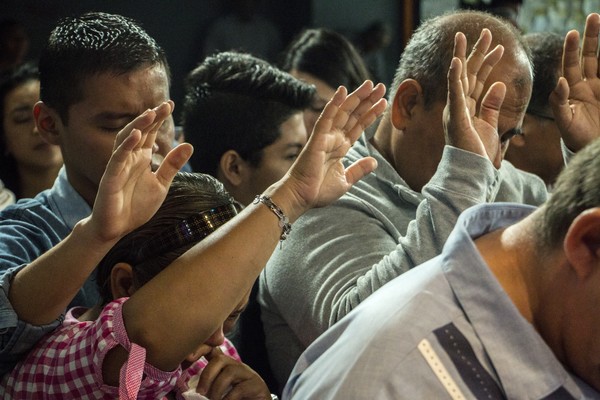South Korea’s cult problem

ASK ANY international student, and chances are that they have been approached by cults—multiple times. Whether it be in front of language Institutes, in the middle of the street, or even in front of Yonsei University’s own gates, students constantly have to evade unwanted interactions with strangers. While most just regard these encounters as annoying, such interactions expose students to potentially harmful situations. Cults in South Korea have refined their recruitment techniques, making it easy for people to unknowingly become their victim.
What is a cult?
In South Korea, the word “cult” does not exist—instead, they are often called I-dan, which means “heresy” in Korean. Heresy, a theological term, refers to beliefs that oppose orthodox religious doctrines. In this way, cults in Korea are seen as any group that strays away from traditional religious doctrines.
UC Santa Barbara identified five criteria—the five “P”—to distinguish a cult. The first is a prophet; a cult needs a man or woman to identify themselves as the “chosen one.” The second is promise: cults teach doctrines derived from misinterpretations of the Bible. Notably, in South Korea, cults opt for a Korea-centric approach. Christian cults interpret Korea as the chosen land and their Korean leader as the new messiah. The third characteristic is plan—cults present their followers with a roadmap as a step-by-step guide to guaranteed salvation. Fourth is possibility—cults constantly try to increase their chances of longevity. Lastly, there is place, an essential characteristic because a physical place allows for centralized control. However, in South Korea, two more criteria can be added. One is fraud under the form of monetary extorsions or sexual crimes committed under the name of religion. The other is syncretism, the amalgamation and merging of different religions and philosophies.

South Korean cult’s diverse history
While Korean cults often choose from Christianity, Buddhism, or Shamanism to base their doctrines on, they also tend to take aspects from other religions. Unlike in the West, various religions peacefully coexisted in South Korean society, and ultimately, each influenced one another. As a result, well-known Christian cults utilize, in addition to the Bible, unidentified shaman texts as doctrines. In this way, cults sometimes utilize shamanistic traditions like talking in tongues. Despite this odd mixing of different religious practices, it is still often difficult to distinguish cults from legitimate churches. Korean Christian cults identify their practices under Presbyterianism, Korea’s most popular Christian denomination, making them more unrecognizable. The deep integration of cults within society originates from traumatic eras of modern Korean history. “Most cults were founded in two main eras: the Korean War and the following military dictatorship,” explains Professor Tark Ji-il, a Busan Presbyterian University professor and cult expert, in an interview with The Yonsei Annals. Professor Tark explains that the instability and unpredictability of these eras fostered the ideal environment for cults to grow. The war fostered fear and pushed people to create these religious groups in search of stability. These cults continued to thrive during the 1960s and 1970s, as the military dictatorship made no distinction between cults from churches. The military dictatorship only cared about which groups gave their support.
However, as society became more secular, depending less on religious communities, cults became less popular. Their approach has since changed, as they often engage in charitable acts like donating blood or participating in environmental movements, to salvage their image.
Why are people attracted to cults?
“People are not attracted to cults; they are made dependent on them,” states Professor Tark. “While joining a cult looks like an individual’s choice, new members actually had little say in it.” Cults are experts at recruiting new members, with their detailed methods to draw in new people.
A common recruitment pattern used by Korean cults is called the B.I.T.E model. The model was first coined by Steven Hassan, a former member of a Korean Christian cult. B.I.T.E stands for behavior control, information control, thought control, and emotional control. Behavior control is the first step of the recruitment process. It begins when cult members first approach a target, they do not ask them to partake in an activity but tell them too. For instance, a cult member would likely assert, “let’s meet here” or “let’s do this.” Information control entails how cults limit member’s access to information. They often warn members to “not believe what you read on the internet,” and equate negative news about the cult to “sin.” Then, cults begin to change the way new members think through “Bible study” activities. During these meetings, Professor Tark explains how “the members try to change the way you perceive the world.” Everything around you seems different—even those closest to you like your friends or family. Finally, the cults try to control your emotions. At this stage, you are disconnected from everyone you know. Isolated, you can only rely on the cult.
Cults have different ways of approaching potential recruits. According to Professor Tark, when cults “approach Korean students, they offer to teach them how to be more studious, be a model, or practice a musical instrument.” When recruiters approach foreign students, they do not tell them who they are. Instead, they propose fun activities such as attending cultural events. When approaching students, December to March presents a critical period for recruiters. Within these months, students finish the Korean university entrance exam and college orientation days take place. Incoming freshmen and even sophomores are likely targets for recruiters: they are new to campus, and often found alone and disoriented. Recruiters approach them in a friendly manner and try to build a connection before offering a Bible study session and start their indoctrination.
While everyone is susceptible to being approached, international students are the desired targets. If a foreigner becomes a member, they are likely to spread the cult’s beliefs once they return home. Yet, most importantly, having foreign members makes the cult seem more legitimate. Certain cults invest in overseas promotion to gain validity. One example is how a Korean cult used a promotional billboard in New York to spread their word. To assert their credibility, certain cults pay for advertisements in overseas newspapers and bring them back to Korea, and then claim that these ads are actually “news reports” about them.
Because of the allure foreign members have, it is not uncommon to hear international students recount their experiences about cults with their friends. The Annals had the opportunity to interview a few students who were willing to share their unnerving encounters.
“I did not want to do anything, but I felt trapped”
In an interview with the Annals, exchange student D[2] recounted how she was approached through the language exchange app Interpals. “I started to talk with this Vietnamese student on the app. She asked if I had any Korean friends, and I didn’t. She then wanted to introduce me to hers, so that I could have a ‘true Korean experience.” Student D met up with the student and her friends for lunch. One of them asked student D if she wanted to have coffee at a “communal space” her aunt ran. “By the time we arrived, I felt uncomfortable, and a little scared, but the place just looked like a normal apartment.” There, student D was first asked if she wished to participate in a Korean ceremony to commemorate her ancestors. After refusing to do so, they proposed another “Korean cultural activity.”
“I had to write down a wish on a piece of paper, and then they would burn it. I did not want to, but I felt trapped.” After translating her wish into Chinese, they forced D to wear a hanbok and started another ritual. Afterward, D went home, feeling uneasy. “I knew a lot about Korea and its culture, and I knew about cults. After some research, I found out others had similar experiences to mine, usually with Buddhist cults. Still, I was so shocked to find out that cults used apps to scam young people.”
“She was the God Mother that gave us life”
In an interview with the Annals, student F recounts how he was approached in front of his school, by who he presumed were students. “During my time at the Korean Language Institute, my friend and I met other students outside the building. When they found out we were from Latin America, one of them started to talk to us in Spanish, telling us she used to live in Argentina,” says student F. “They invited us for a pleasant coffee and dinner. The lady told us about an exhibition on the mitochondria she wanted us to go to. We agreed, attracted by the free dinner she offered.” Student F and his friends went, only to find out it was a church. Thousands were there, and they showed a video of a middle-aged woman wearing a hanbok. “We kept asking who she was, but everyone refused to tell us. The video presented the mitochondria as the unit of life. As such, it came from a ‘God Mother’ that gave us life,” says student F. While the video was unexpected, student F considered the situation to be relatively normal, still within the traditional boundaries of religion—except for the “God Mother.” “The video informed us that the end of the world was near, and that those who did not adhere to the church were condemned,” says student F. “We tried to shake it off. But after, we were cornered in a room where we read about the apocalypse and were told to be immediately and ‘correctly’ be baptized in a pool.” Student F and his friends left, only to find out that the cult was connected to cases of human trafficking.
“They were nothing but nice to me…”
In an interview with the Annals, student M recounts her time of one month and a half with a cult. Student M stated, “I was approached under the pretext of language exchange. I had heard Korea was extremely safe, and never heard anything about cults.” Student M was invited to dinner, where she met up with a group of girls. “They had been all around the world, and they were so nice—I felt like I fit in,” says student M. After several meals and coffee dates, Student M felt a genuine connection with them. “One of them asked if I liked football and invited me to a game in Daejeon. I was excited for the free trip,” says student M. But the game was nothing like student M expected. At the entrance, security put red tape on her phone camera. She recalls, “They told me it was for copyright issues; I was confused but I did not feel like I should speak up about it.” During the day, she realized that it was an amateur football match playing against an old man—and everyone was obviously letting him score. Comments like “Do you see how the ‘Teacher’ is great? He used to be a soccer player back in his day” were being exchanged, and student M could not believe they thought the game was genuine. “I really liked them, so I just let it slide. They invited me on many trips, and I never paid a cent,” says student M, who did not think much of it until they forced her to do a religious tour and attend a Bible Study. “I started asking question who their leader was, and what was this ‘sanctuary’ that he built? When I refused to believe their partial and ridiculous answers, I was told I was not ‘enlightened enough’ to understand,” says student M. Suddenly, after spending almost every day together, student M’s friend never spoke to her again.

COVID-19, a new era for cults
Korean society used to see cults only as a theological problem, as they mainly conflicted with churches. It was not until the spread of COVID-19 by the Shin-cheon-ji that cults ceased to be seen solely as a religious concern. “Because of their lies, the cult victimized the whole of Korean society,” says Professor Tark. “Since the Korean War, many families have been destroyed silently [by cults]. Now, society has a new-found critical understanding of cults as social problems.” This new perception led the government and society to be on the lookout for problematic cult activities. While politics used to be cautious when it came to cults, Moon Jae-In’s government is not hesitant to publicly criticize them[1]. Even though cults now face greater societal criticism, COVID-19 also marked a shift in how they operate.
Due to the social distancing regulations, cults have moved their recruitment and activities from offline to online. The online space offers cults anonymity and allows them to target a wider range of people. “There is no longer a safe time nor space. Even those in mandatory military service are exposed to recruiters,” says Professor Tark. Cults now often utilize apps like HelloTalk and other social media outlets to attract new members or spread a message. They use these platforms to announce their activities, such as the Sarang Jeil Church's use of YouTube to promote their protest against COVID-19 regulations.
Since cults’ offline activities have been limited to some degree during the pandemic, their presence within the student community seems to have decreased. However, as the pandemic comes to an end, cults may again revert to their pre-COVID-19 operations.
* * *
While South Korea’s cults remain at the fringes of society, their historical foothold entails that they are not disappearing anytime soon. As such, it is important to be aware of their tactics. If someone approaches you with the premise of engaging in a “cultural exchange” or offers to teach you a new “skill,” be sure to second-guess their motives. One often does not know they are involved in a cult until it is too late. Therefore, it is important to understand the prevalence of cults in South Korean society and recognizing their methods is a good first step to shield yourself and others from their grasp.
If you are experiencing a difficult time with any religious movement, you can contact the Yonsei chaplains, who are experienced and can help your situation. Do not be afraid to reach out: chapel@yonsei.ac.kr / 02-2123-2038
[1] The New York Times
[2] D is an alias chosen by a victim who wished to remain anonymous.
[3] F is an alias chosen by a victim who wished to remain anonymous.
[4] M is an alias chosen by a victim who wished to remain anonymous.

